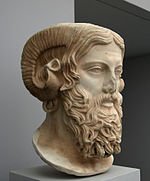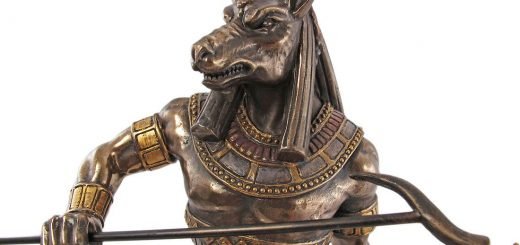Amun: Origin Story, Family, Meaning, Symbols, Power, & Facts

Popularly known as the Hidden God, Amun was an ancient Egyptian god of the Sun and the air
Amun was a major god in ancient Egyptian religion who possessed numerous roles. As a sun deity, he was the “Revealed One” or the “Exposed One” who was the father of many gods including Khonsu. His role as the sun god made him a widely worshiped Egyptian deity. He was particularly prominent in the Egyptian city of Thebes throughout the New Kingdom era. Thebians revered him as the king of the Egyptian pantheon, believing that he was the god that created everything at the beginning of time.
Reverence of Amun shot up following his merger with another sun deity by the name of Ra (Re). He would then go on to be called Amun-Re or Amun-Re. In that role, he became the symbolic father of the Egyptian gods and their earthly representatives on earth. As a patron god, he had numerous consorts, including Mut, Worset, and Hathor.
Ancient Egyptians had many many epithets to describe Amun; this includes “Father of the gods”, “the Hidden One”, “Maker of men”, “Lord of truth”, and “the Invisible”. Amun being the “Mysterious One” meant that he was sometimes a well-defined solar deity and on other times he simply stayed hidden like the wind. That latter feature allowed the ancient Egyptians to associate and identify him with a plethora of deities.
Myths and Facts
God of: the sun and air
Consort: Mut, Worset, Aunet, Hathor
Children: Khonsu
Symbols: two vertical plumes, ram
Epithets: “Father of the gods”, “the mysterious One”, “the Hidden One”, “Maker of men”, “Lord of truth”, “the Invisible”, and “Creator of the staff of life”.
Other names: Amon, Amen, Ammon
Major worship place and cults: Thebes
Greek equivalent: Zeus
Roman equivalent: Jupiter
Origins and Family
His worship dates back to the Old Kingdom Era (c. 2686-c. 2181 BCE). According to an ancient document from that era – the Pyramid Text – he was revered as a fertility and protection god. Egyptians considered him a primordial deity, a member of the Ogdoad [eight primordial gods at the beginning of creation], in charge of the mysterious part of creation. For this, he was given the title “The Mysterious One” or “The Hidden One”.
His worship rose to prominence across Egypt after he became the patron god of the city of Thebes. Beginning around the Middle Kingdom (c. 2040- c.1780 BCE), the city’s inhabitants also viewed him as the husband of the mother goddess Mut and the father of the Moon god Khonsu. Together with those two deities, Amun made up the highly respected Theban Triad of Gods.
Prior to him gaining prominence in Thebes, Egyptians of the Old Kingdom revered the war god Montu as the city’s patron. Amun, although powerful, was only associated with protecting Egyptian kings and royals. He was mainly a fertility deity, and his consort was Amaunet.
Worship of Amun
As stated above, his worship was predominantly worshiped in the city of Thebes, starting from the New Kingdom era. However, his worship and following slightly declined during the reign of the Hyksos in the Second Intermediate Period (c. 1780 BCE- c. 1570 BCE). After the Hyksos were expelled [by Ahmose I] from Egypt, Amun regained his place as the preeminent deity in the city of Thebes.
Throughout the New Kingdom, no other Egyptian god was as popular and revered as Amun (or Amun-Ra). Nineteenth Dynasty (1292 BCE-1189 BCE) pharaohs like Ramesses II, Seti I and Merenptah were very fond of this god and his worship. Those pharaohs were known for building spectacular temples and complexes in honor of the god. The Temple of Amun at Karnak in Thebes ranked as one of the most famous places for the worship of Amun.
The Karnak Temple which houses the Temple of Amun was the largest religious complex in ancient Egypt. Construction of the complex started during the reign of Pharaoh Senusret I of the Middle Kingdom.

Located in Thebes in Upper Egypt, the Karnak Temple Complex of ancient Egypt was a famous place for the worship of Amun
How Amun became Amun-Ra, the creator god
After the Hyksos rulers were driven out of Egypt by Ahmose I, the worship of Amun became more widespread. Ahmose I and the subsequent rulers in the 18th Dynasty believed that this god was responsible for their military conquests over the Hyksos.
Gradually, other Egyptian gods from different parts of the country became associated with Amun. This association was influenced by the god’s feature of being the “The Obscure One”. With such an undefined role, Egyptians could associate many gods to Amun. The god was given many characteristics and could be whatever the Egyptians required him to be.
By the end of the New Kingdom, he had fully assimilated almost all the roles and characteristics of sun god Ra as well as an earlier sun god known as Atum. He would then go on to be called Amun-Ra or Amun-Re, the creator god and king of Egyptian gods. With this merger, he earned a higher title, “The Self-Created One”. And in spite of his association with the sun, Egyptians still referred to him as “the Concealed God”, a reference to his original features, as well as his association with air.

Amun’s features were combined with that of the sun god Ra to form a powerful deity known as Amun-Ra
Popular epithets of Amun
He was described in a number of different ways, with many of those descriptions reflecting his self-creation feature following his merger with the sun god Ra. For example, he has been described as the “Lord of Truth”, “The Secret One”, “Maker of Men”, and the “Creator of the Essence of Life”.
Symbols and Depictions

Amun – symbols and depictions
The commonest depictions of the god show him as a long bearded man standing in an upright position. In both of his hands are the ankh [Egyptian symbol of life] and the was staff [ the symbol of power and royalty]. Atop his head is a headdress shaped in the form of two long plumes.
Ancient Egyptians also borrowed a few traits of the Kushite’s patron deity and then incorporated them into his depictions. For example, he was sometimes depicted with the head and curved horns of a ram. To the Egyptians, the curved horns represented his traits as fertility deity.
Finally, some of his depictions show him with a blue skin instead of the typical red-brown skin. The Egyptians associated the color blue with creation and air.

Statue of Ramesses II flanked by Amun (left) and Mut (right) at the Museo Egizio of Turin, Italy
Amun’s Roles and Powers
Amun or Amun-Ra was primarily in charge of maintaining peace and tranquility in the land of Egypt. Egyptians believed that he was the deity who upheld justice, truth and order. The principles this god espoused were were also known as the Principles of Ma’at. For this, he was sometimes called “The Lord of Truth”.
According to some ancient texts, he was also seen as the “Protector of the Road”; he was the deity that came to the aid of the most vulnerable people in the society, guiding them and giving them the justice they deserve.
He was also revered for granting mercy to people who went against the principle of Ma’at. He had so many roles in the Egyptian pantheon that some Egyptians referred to him as “Amun rich in names” (asha renu) or the “The Lord of All”. The latter epithet means that his spirit permeated everything that exists in the universe.
Other important myths and facts about Amun

Merged with ancient Greek god Zeus, Amun became the bearded Zeus-Ammon| A bust of Zeus Ammon (Roman copy of a Greek original from the late 5th century BCE)
The Pyramid Texts of the Old Kingdom era is widely regarded as the first source material, describing who the creator god Amun is as well as his role in the Egyptian pantheon.
Owing to his association with Min, a fertility goddess, he was sometimes called Amun-Min.
Pharaoh Amenhotep IV of the 18th Dynasty spent almost all of his reign trying to replace Amun as the chief god of the pantheon with a different sun deity known as Aten. For this, Amenhotep IV, as well as his immediate successor Tutankhamun, was smeared as a heretic pharaoh. Amenhotep even went as far as changing his name to Akhenaten in order to honor his sun god Aten. He also moved the capital city from Thebes to Akhetaten.
Following his merger with Ra and Atum, the Priests of Amun became very powerful. At some point in time, the power the priests wielded even rivalled that of the Egyptian pharaohs. Some scholars opine that Akhenaten’s so-called radical reforms were in fact aimed at curtailing some of the powers that the priests possessed.

Amun’s critically acclaimed hidden component enabled him to be identified with many Egyptian deities. This explains why he could take on the names of those gods, including Amun-Re-Atum and Amun-Re-Montu | Image: Amun-Min – the combination of features of the fertility god Min and Amun
To the ancient Greeks, he was known as Ammon; he was the equivalent of their chief god, Zeus. Together, the two gods became the bearded Zeus-Ammon. In ancient Rome, a similar thing happened; there was a god named Jupiter-Ammon who had similar origin story and powers as that of Amun.
By virtue of the fact that Ahmose I attributed Egypt’s victory over the Hyksos rulers to Amun, he was given some of the attributes of Montu, the Egyptian war god.
Following Alexander the Great’s triumphant march into Egypt, the Egyptians hailed him as the son of Zeus-Ammon.
Right up until the Ptolemaic Era (305 BCE to 30 BCE), Egypt still worshipped Amun. Some scholars even state that the his cult thrived up until the fifth century CE, when it made way for Christianity.
Amun’s extremely important feature – his ability to synchronize with many deities – made him an enduring force since the beginning of the ancient Egyptian civilization. This explains why he could acquire the names of those gods that he was associated with. For example, he was known at various points in ancient Egypt as Amun-Re-Atum, Amun-Re-Montu, Min-Amun, and Amun-Re-Horakhty.
You may also like: 12 Greatest Cities in Ancient Egypt



























